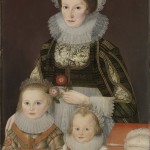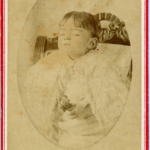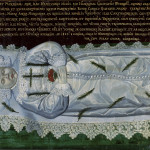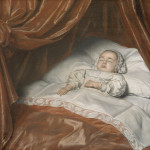Portrait of a Dead Child by Artist of English School, 1624
Infant mortality was high in seventeenth-century England. Although it was not unusual for women to become pregnant nine or ten times, often as few as one or two children survived to adulthood. The child frequently failed to survive the birth or fell prey to disease or malnutrition at an early age. Because of the high risk of a child’s dying during birth, priests were usually present during labor. If disaster should occur, they were on hand to baptize the baby, which was thought necessary to enable it to enter heaven and avoid eternal damnation. Boys were particularly mourned if they perished at an early age, because parents were anxious to have a healthy son to carry on the family name.
According to the inscription on the picture, the child portrayed here passed away in 1624, at around the age of four or five. Although the flowers appear embroidered, they represent real flowers sprinkled on the on the linen – the daffodil is clearly hanging over onto the brown blanket; also visible are ears of wheat and a wild rose. Although these plants had specific connotations, such as the daffodil symbolizing young life, it is more likely that they served a more practical purpose, that of masking the unpleasant smell of death. These flowers were often arranged in the hair of the deceased or carefully placed in his hands so that he appeared to be holding them.
In the background of the painting is a small shelf with a dish containing a small pipe and bubble. The bubble alluded to the child’s last breath and was a traditional symbol of the transience and fragility of life – a theme echoed in the butterfly that hovers in the embroidery above the child’s head.
Via: WikiCommons, Denver Art Museum





